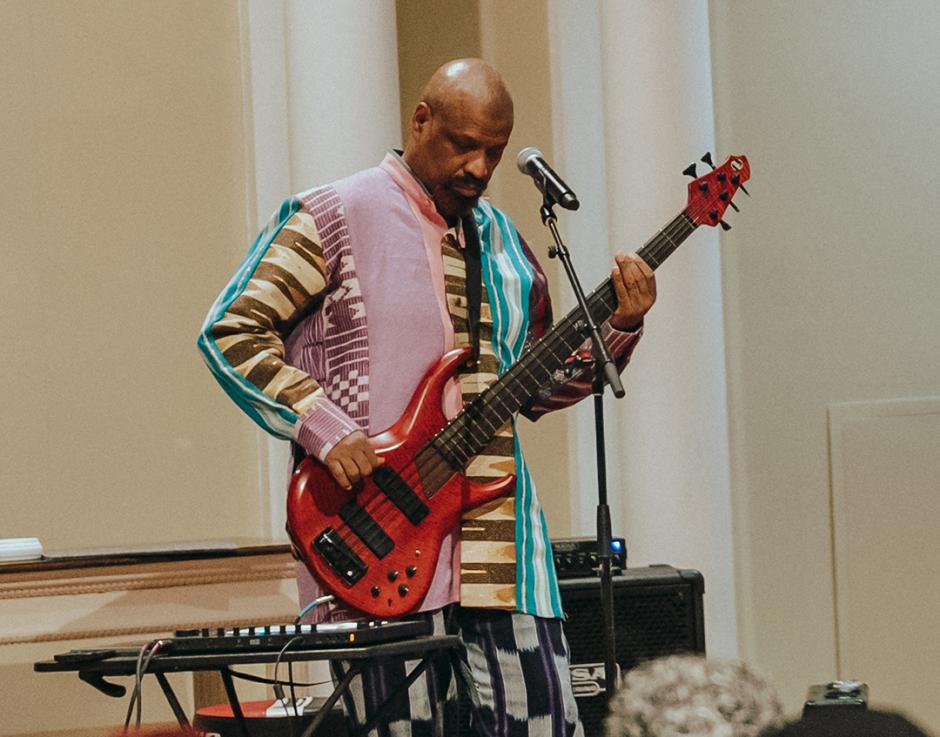“Postmodern future funk rock”: Melvin Gibbs reviewed
September 2025

Melvin Gibbs. Photo by Christian Stewart
The latest project from bassist Melvin Gibbs updates the bold collage techniques of 1970s Miles Davis and Teo Macero, writes Phil Freeman in The Wire 500
Melvin Gibbs
Amasia: Anamibia Sessions 2
Hausu Mountain CD/DL/LP
Bassist Melvin Gibbs made his professional debut in 1980 with Defunkt, the avant funk band led by trombonist Joseph Bowie. Within the year, though, he’d moved on, joining drummer Ronald Shannon Jackson’s Decoding Society alongside guitarist Vernon Reid and saxophonist Byard Lancaster. He stayed with Jackson for six studio albums and numerous tours, playing high volume, high speed harmolodic funk rock that stunned audiences into submission.
Drawn into John Zorn’s orbit, Gibbs appeared on Spillane and The Big Gundown. He formed Power Tools, a trio with Jackson and guitarist Bill Frisell (a later line-up featured Pete Cosey, but never recorded). He joined Sonny Sharrock’s band while also beginning a partnership with Arto Lindsay in Ambitious Lovers, then swerved into arty metal with Rollins Band, helping pull them away from Helmet-ish rage and toward a more meditative, swinging sound, like a jazzier, dubbier King Crimson. Still later, he was an occasional collaborator with writer Greg Tate’s amorphous improvising ensemble Burnt Sugar, anchoring The Rites, their wild reinterpretation of Stravinsky’s Rite Of Spring.
Gibbs has also led several projects of his own over the years. His first solo album Pass Me By was released on the German label Rhythm Attack in 1988. It featured Vernon Reid and vocalist DK Dyson, the latter of whom would join him in the psychedelic rock band Eye & I. They made one album for Epic in 1992, which included a head-spinning version of The Velvet Underground’s “Venus In Furs”. And in the late 1990s, he formed the atmospheric power trio Harriet Tubman with guitarist Brandon Ross and drummer JT Lewis. They made a few low profile albums, and then after nearly 20 years, the world took notice. Their 2017 album Araminta, a collaboration with trumpeter Wadada Leo Smith, and the follow-up, 2018’s The Terror End Of Beauty, turned dubby hard rock into something that sounded like a distant thunderstorm heard through a half-open window.
Lately, Gibbs has been recording and performing as part of Body Meπa (pronounced Body Meta, like the Ornette Coleman album), a quartet featuring Sasha Frere-Jones and Grey McMurray on guitars, and Greg Fox on drums. Their two albums, 2021’s The Work Is Slow and 2024’s Prayer In Dub, contain simple instrumentals that raise the question of so much minimalist music: how do you know when it’s time to stop? The first track on The Work Is Slow, the nearly 15 minute “Horse Flower Storm/Fabuloso”, is something like a post-rock version of Miles Davis’s “Nefertiti” – the guitars and bass play endless, slightly differing versions of one simple melodic figure, the harmonic relationships wavering, then reestablishing themselves, over and over and over. Behind them, Fox does whatever he wants, making the beat more or less active, transitioning from a jazzy lope to a more punk rock hammering, but keeping the tempo consistent.
Body Meπa’s music isn’t quiet or shy; the guitars are often blown out and noisy. But the serenity at its heart often seems to be key to Gibbs’s work, whether with Rollins Band, where he replaced the fierce slapping of Andrew Weiss with an undersea rumble, or with Harriet Tubman, where he is the slowly pulsating midpoint between Ross’s superstorms of guitar and Lewis’s sharp-edged drumming.
Recently, Gibbs has been exploring electronic music and sound design. The first volume of his Anamibia Sessions series, The Wave, began life as a soundtrack to a film by Arthur Jafa. Released on Editions Mego, it’s a collection of hisses and hums and processed field recordings that recalls early 2000s ultra-minimalist electronic music by Bernhard Günter or Taylor Deupree.
Amasia: Anamibia Sessions 2 is very different. It’s a collection of pieces featuring a wide range of instrumentalists recorded in 2006 and 2025 in various studios, and assembled after the fact. The late guitarist Pete Cosey appears on three tracks, JT Lewis of Harriet Tubman is heard on two, Greg Fox of Body Meπa is on one, and other guests include keyboardists Onaje Allan Gumbs and John Medeski, and trumpeter Chris Williams. Gibbs, who’s credited with bass, editing, sound design and arrangement, and occasional drum programming, takes all their contributions and reassembles them in new contexts, a methodology that’s been part of Black music-making since Miles Davis’s Bitches Brew recording sessions in August 1969, if not before. But the collage techniques of hiphop are part of Gibbs’s toolbox too, as they’ve been going all the way back to Pass Me By.
The opening track “Felonious Monk” has a dark, halfway lost feel reminiscent of DJ Krush; multiple other tracks feature beatboxing from Napoleon Maddox, but rarely as a foreground element, just part of the atmosphere. The album’s centrepiece, the 13 minute “Luigi Takes A Walk”, layers stinging guitar from Cosey and alto sax from Casey Benjamin over dense banks of keyboards, fuzz bass and drums from both Lewis and Fox, creating a Burnt Sugar-esque postmodern future funk rock. And then, after “OG Dreams Of Lost Love”, all electronically warped flute, beatboxing and melancholy synth, it all dissolves, like waking from a dream.
This review appears in The Wire 500 along with many other reviews of new and recent records, books, films, festivals and more. To read them all, pick up a copy of the magazine in our online shop. Wire subscribers can also read the issue in our online magazine library.
Leave a comment